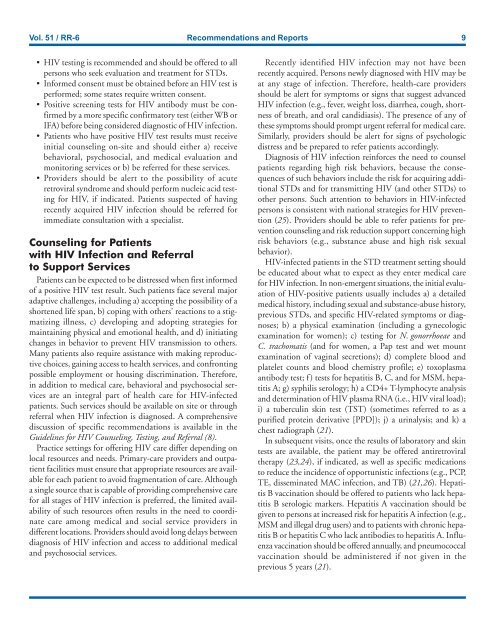You also want an ePaper? Increase the reach of your titles
YUMPU automatically turns print PDFs into web optimized ePapers that Google loves.
Vol. 51 / RR-6 Recommendations and Reports 9<br />
HIV testing is recommended and should be offered to all<br />
persons who seek evaluation and treatment for STDs.<br />
Informed consent must be obtained before an HIV test is<br />
performed; some states require written consent.<br />
Positive screening tests for HIV antibody must be confirmed<br />
by a more specific confirmatory test (either WB or<br />
IFA) before being considered diagnostic of HIV infection.<br />
Patients who have positive HIV test results must receive<br />
initial counseling on-site and should either a) receive<br />
behavioral, psychosocial, and medical evaluation and<br />
monitoring services or b) be referred for these services.<br />
Providers should be alert to the possibility of acute<br />
retroviral syndrome and should perform nucleic acid testing<br />
for HIV, if indicated. Patients suspected of having<br />
recently acquired HIV infection should be referred for<br />
immediate consultation with a specialist.<br />
Counseling for Patients<br />
with HIV Infection and Referral<br />
to Support Services<br />
Patients can be expected to be distressed when first informed<br />
of a positive HIV test result. Such patients face several major<br />
adaptive challenges, including a) accepting the possibility of a<br />
shortened life span, b) coping with others’ reactions to a stigmatizing<br />
illness, c) developing and adopting strategies for<br />
maintaining physical and emotional health, and d) initiating<br />
changes in behavior to prevent HIV transmission to others.<br />
Many patients also require assistance with making reproductive<br />
choices, gaining access to health services, and confronting<br />
possible employment or housing discrimination. Therefore,<br />
in addition to medical care, behavioral and psychosocial services<br />
are an integral part of health care for HIV-infected<br />
patients. Such services should be available on site or through<br />
referral when HIV infection is diagnosed. A comprehensive<br />
discussion of specific recommendations is available in the<br />
Guidelines for HIV Counseling, Testing, and Referral (8).<br />
Practice settings for offering HIV care differ depending on<br />
local resources and needs. Primary-care providers and outpatient<br />
facilities must ensure that appropriate resources are available<br />
for each patient to avoid fragmentation of care. Although<br />
a single source that is capable of providing comprehensive care<br />
for all stages of HIV infection is preferred, the limited availability<br />
of such resources often results in the need to coordinate<br />
care among medical and social service providers in<br />
different locations. Providers should avoid long delays between<br />
diagnosis of HIV infection and access to additional medical<br />
and psychosocial services.<br />
Recently identified HIV infection may not have been<br />
recently acquired. Persons newly diagnosed with HIV may be<br />
at any stage of infection. Therefore, health-care providers<br />
should be alert for symptoms or signs that suggest advanced<br />
HIV infection (e.g., fever, weight loss, diarrhea, cough, shortness<br />
of breath, and oral candidiasis). The presence of any of<br />
these symptoms should prompt urgent referral for medical care.<br />
Similarly, providers should be alert for signs of psychologic<br />
distress and be prepared to refer patients accordingly.<br />
Diagnosis of HIV infection reinforces the need to counsel<br />
patients regarding high risk behaviors, because the consequences<br />
of such behaviors include the risk for acquiring additional<br />
STDs and for transmitting HIV (and other STDs) to<br />
other persons. Such attention to behaviors in HIV-infected<br />
persons is consistent with national strategies for HIV prevention<br />
(25). Providers should be able to refer patients for prevention<br />
counseling and risk reduction support concerning high<br />
risk behaviors (e.g., substance abuse and high risk sexual<br />
behavior).<br />
HIV-infected patients in the STD treatment setting should<br />
be educated about what to expect as they enter medical care<br />
for HIV infection. In non-emergent situations, the initial evaluation<br />
of HIV-positive patients usually includes a) a detailed<br />
medical history, including sexual and substance-abuse history,<br />
previous STDs, and specific HIV-related symptoms or diagnoses;<br />
b) a physical examination (including a gynecologic<br />
examination for women); c) testing for N. gonorrhoeae and<br />
C. trachomatis (and for women, a Pap test and wet mount<br />
examination of vaginal secretions); d) complete blood and<br />
platelet counts and blood chemistry profile; e) toxoplasma<br />
antibody test; f) tests for hepatitis B, C, and for MSM, hepatitis<br />
A; g) syphilis serology; h) a CD4+ T-lymphocyte analysis<br />
and determination of HIV plasma RNA (i.e., HIV viral load);<br />
i) a tuberculin skin test (TST) (sometimes referred to as a<br />
purified protein derivative [PPD]); j) a urinalysis; and k) a<br />
chest radiograph (21).<br />
In subsequent visits, once the results of laboratory and skin<br />
tests are available, the patient may be offered antiretroviral<br />
therapy (23,24), if indicated, as well as specific medications<br />
to reduce the incidence of opportunistic infections (e.g., PCP,<br />
TE, disseminated MAC infection, and TB) (21,26). Hepatitis<br />
B vaccination should be offered to patients who lack hepatitis<br />
B serologic markers. Hepatitis A vaccination should be<br />
given to persons at increased risk for hepatitis A infection (e.g.,<br />
MSM and illegal drug users) and to patients with chronic hepatitis<br />
B or hepatitis C who lack antibodies to hepatitis A. Influenza<br />
vaccination should be offered annually, and pneumococcal<br />
vaccination should be administered if not given in the<br />
previous 5 years (21).


